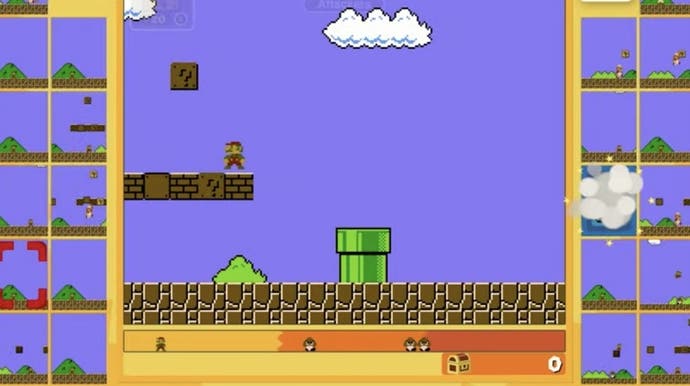Super Mario Bros. 35 is not Battle Royale so much as Mario without the Memory Tax
It's-a who?
It's rare, I suspect, to wake up on your 35th birthday feeling young again - but then, Mario is not your typical fellow. Super Mario Bros. 35 takes its strange lead from Tetris 99: another free download (if you are part of Nintendo's Online thingy) that reinterprets a single-player classic as a massively-multiplayer affair. It's very interesting, though. Tetris 99 pits you against dozens of other Tetris players, all stuffed in their own Celebrity Squares spots on the edges of the screen, and it really feels like a Battle Royale. Mario does a similar trick, with 34 other players, obv, and it doesn't feel like a Battle Royale at all. Not to get too cosmic, but this is a Mario game that drives you inward.
I think this is down to the kind of memories I have of Super Mario Bros, the game that Mario 35 repurposes. This is one of my first real memories of a video game place, a place that I learned to live in quite thoroughly through endless cross-legged repetition. Even now I can predict the arrivals of a Goomba or a Bullet Bill. Even now I know that peculiar inertia of Mario as he takes to the air or changes direction.
So to see these places reconfigured puts me right back in the centre of my mind again, deep down, in a sort of fascinated isolation as I try to understand what has changed. The point of Mario 35 is to play Mario better than anyone else. Your victories send enemies - Goombas, Koopas, what have you - onto rival screens while their victories send enemies onto yours. This means that I'll be playing 1-1 and I'll suddenly find three ghostly Goombas trotting along where they had never trotted along before, utterly breaking the sequence. Mario is challenging again, and freed from years of what chess players refer to as Memory Tax.

Without changing the landscapes, then, Nintendo has found a way to utterly change the flow and feel of the game. And your agenda within it. As stomped enemies help fill your time meter, which is always ticking down to zero, the more enemies that are sent your way means the more potential you have to give yourself breathing room. What this does for a level like 1-2 is utterly astonishing. This underground cavern is transformed into a gauntlet of opportunity, a narrow corridor that is often completely filled with enemies. You can die so easily here! In 1-2! I know! But also, look at the possibilities you now have to emerge from 1-2 with a real lead on the rest of the pack.
Except, to be honest, I never find myself thinking of the rest of the pack. In Tetris 99 your rivals are always on your mind. But Mario 35 really does seem to drive me inward: I play it in glorious solitude, just me and these new ghostly baddies who are chucked my way every now and then.
Maybe the Memory Tax thing is the way to understand this. Over the centuries, dozens of people have tried to reimagine Chess all with one aim: to free the game from people's expectations of it, from the standardised openers that give way to the standardised end-games, to allow for more of what the chess greats call Brilliancies, a particular match that is beautiful and memorable and unique. I wonder, playing Mario 35, if Super Mario Bros isn't secretly a bit like Chess in this regard - have my fond memories of it also trapped it a little over the years, drained it of colour and surprise? And has Nintendo managed to bring it back to life for its birthday? Well played.



